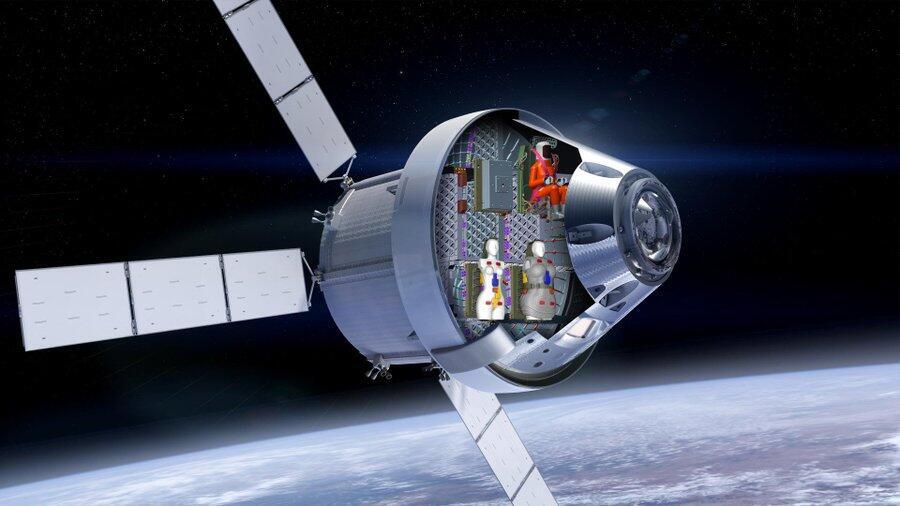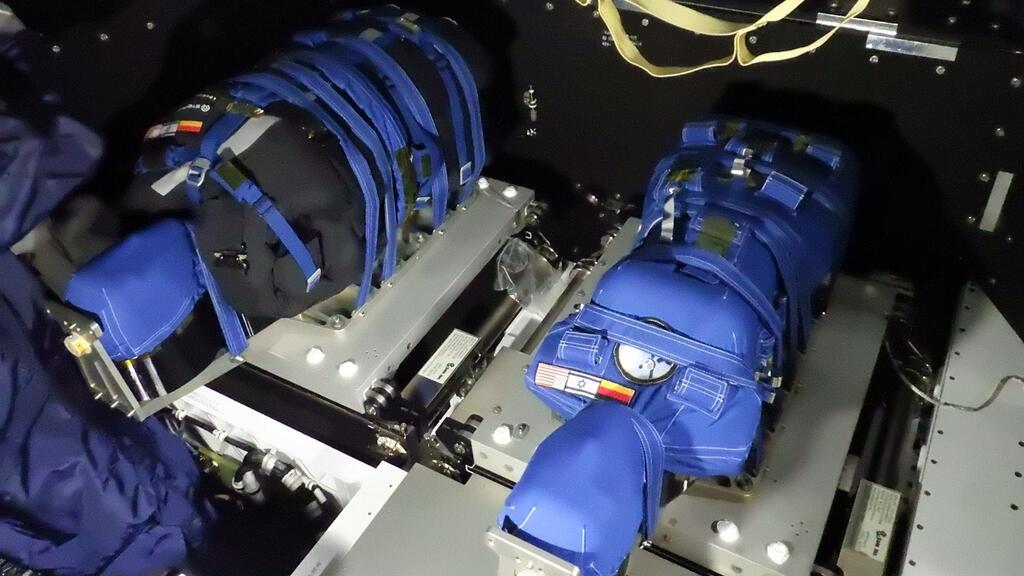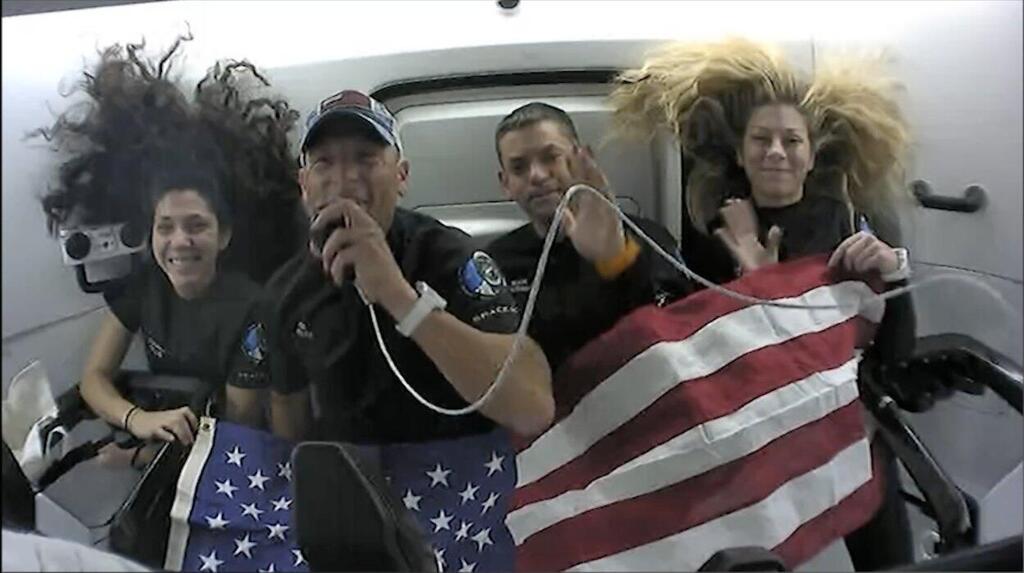Getting your Trinity Audio player ready...
Radiation protection on the way to the moon
Nearly two years after the Artemis 1 mission, which tested the Orion spacecraft on an uncrewed flight around the Moon, the first scientific paper on radiation levels measured during the journey to the Moon was published last week.
The Israeli-American company StemRad participated in the experiment, developing a protective vest to shield astronauts from particle radiation during strong solar storms. The experiment was conducted with the involvement of the Israel Space Agency and led by researchers from the German Space Agency (DLR) and NASA.
Radiation levels were monitored by numerous sensors placed in various sections of the spacecraft, as well as on and inside two life-sized mannequins, Helga and Zohar—one unprotected and the other equipped with the Israeli protective vest. Published in the journal Nature, the paper does not yet evaluate the performance of the Israeli vest but offers a comprehensive overview of the radiation levels recorded during the mission.
Notably, these levels were encouragingly low, posing minimal risk to astronauts on such a mission. "The Orion spacecraft’s design includes radiation shielding, and we can attribute the relatively low measurements to this shielding compared to what was recorded during the Apollo program," explained Dr. Christine Hellweg, head of the department of Radiation Biology at the Institute of Aerospace Medicine at the DLR, in an interview to the Davidson Institute's website.
"At the peak radiation level, during crossing through the inner Van Allen belt, the radiation levels in the less shielded areas of the spacecraft were four times higher than in the most shielded area."
One of the primary functions of the spacecraft's shielded areas is to serve as a refuge for astronauts during solar storms, when the Sun emits large amounts of highly energetic particles. According to Hellweg, the findings suggest that the Orion spacecraft will remain safe even during these events.
“In terms of radiation exposure, the Orion spacecraft is safe for a lunar journey in accordance with the framework of the Artemis program, for a duration similar to Artemis 1 during 'quiet' periods of the sun,” she clarified.
“In the event of a strong solar storm, astronauts would need to remain in the more shielded part of the spacecraft. The mission data, combined with simulations we've conducted, show that even during a strong solar storm, the shelter provides good protection, and astronauts are unlikely to suffer from radiation sickness.”
In terms of radiation protection, the paper's authors estimated that the Orion spacecraft, or a similarly shielded vehicle, could also be suitable for a Mars mission, which would last significantly longer than a trip to the Moon.
“Projections for a manned mission to Mars indicate radiation levels 30% lower than previously calculated, meaning that in such a mission, including a short stay on Mars, astronauts would not exceed NASA’s maximum allowable cumulative radiation exposure level, provided solar activity remains similar to that during the Artemis 1 mission,” Hellweg explained.
As noted, this paper did not examine the effectiveness of the Israeli "AstroRad" protective vest, and the level of protection it provides against radiation. “The data on the vest that protected Zohar during this journey will be published soon and will highlight its importance, both in terms of health and operational efficiency,” said StemRad co-founder and CEO Dr. Oren Milstein to the Davidson Institute website.
“The paper published now shows the capabilities of the Orion spacecraft to take us further— to the Moon and even to Mars. Radiation protection will become increasingly important as we advance on this exciting journey for humanity.”
Violin and Doritos in space
The pioneering private space mission, Polaris Dawn, successfully concluded as planned on Sunday last week, with a splashdown near the southern tip of Florida. The mission achieved several historic milestones, including the southernmost landing of a manned spacecraft in the Gulf of Mexico.
On the first day of the mission, the spacecraft achieved a major historic milestone, reaching an altitude of approximately 1,400 kilometers above Earth—a height not attained by humans since the Apollo missions. This achievement also made crew members Sarah Gillis and Anna Menon the highest-flying women ever. The mission's highlight was the first-ever "spacewalk" by private astronauts.
The spacecraft was depressurized, exposing four humans to the space environment simultaneously for the first time. Following this, mission commander and financier Jared Isaacman became the first private astronaut to venture into space in a spacesuit. In fact, he only extended half of his body outside the spacecraft to test SpaceX's new spacesuit for a few minutes.
Gillis followed him, adding another historic milestone toward the end of the mission by becoming the first person to play the violin in space. She performed a piece from one of the Star Wars films, which was broadcast to Earth via SpaceX's Starlink satellites, marking their first use for spacecraft communication.
Polaris Dawn astronauts in space
(Video: SpaceX)
In another first, the mission crew, including pilot Scott Poteet, became the first to eat Doritos in space. Frito-Lay, the snack’s manufacturer, created special packaging with smaller, crumb-free chips and oil-based seasoning to prevent spices from dispersing as dust inside the spacecraft.
This playful addition wasn’t just a publicity stunt—it also raised funds for a children's cancer hospital in Memphis. Frito-Lay donated over half a million dollars, with additional proceeds expected from auctioning items taken into space by the crew.
Polaris Dawn is the first of three planned missions in the Polaris program, all funded and commanded by Isaacman aboard SpaceX spacecraft. The goals for the second mission will be determined based on the first mission's outcomes, with no details yet released.
One proposal was to raise the Hubble Space Telescope to a higher orbit to extend its operational life, but NASA declined the offer. The third mission is expected to take place on SpaceX’s Starship spaceship, potentially marking its first manned flight, although the spacecraft is still undergoing testing.
The wet moon
While our Moon appears barren, it holds significant potential for water extraction. This is the conclusion of a new study by scientists who analyzed data from the spectrometer aboard India’s first lunar satellite, Chandrayaan-1, which orbited the Moon for nearly a year before its mission concluded in 2009.
Previous studies had identified signs of frozen water beneath the surface near the poles, particularly in polar craters that are never exposed to sunlight. There was also evidence of water molecules trapped in volcanic glass crystals.
The new findings suggest that rocks containing water molecules are present across all lunar latitudes, including both the near and far sides of the Moon—far beyond the polar regions. These conclusions are based on spectral measurements of sunlight reflected off the Moon’s surface, particularly in the infrared range, which can precisely detect the chemical signature of water molecules.
The researchers discovered that several types of lunar rocks contain minerals associated with water molecules, most of which are located below the surface. The outer layer of these rocks is richer in hydroxyl (OH)—a molecule composed of one oxygen atom bonded to a single hydrogen atom—rather than the typical two hydrogen atoms found in water (H₂O). This is likely the result of solar wind particles, which, over millions of years, have knocked hydrogen atoms off the water molecules in surface minerals.
5 View gallery


A photo of the Moon’s surface captured by Chandrayaan-1 (top) alongside a mineralogical map of the same area
"Future astronauts may be able to find water even near the equator by exploiting these water-rich areas," said lead Roger Clark, Senior Scientist at the Planetary Science Institute. "Knowing where water is located not only helps to understand lunar geologic history, but also where astronauts may find water in the future.”
However, because this water is stored within minerals, it is not easily accessible. To extract it, astronauts would need to heat the rocks in specialized facilities to capture water vapor and separate it from other gasses.
This is not impossible but far more complex than mining ice. On the other hand, this process would allow for the extraction of hydroxyl, which could be converted into water. Additionally, combining four hydroxyl ions in a reaction can produce two water molecules and one oxygen molecule (O₂), offering a dual benefit for future lunar missions.
Any reception?
When humans begin working on the Moon for extended periods, they will not only need water and other vital resources but also a reliable and efficient way to communicate and transfer data between crews, bases, and stations operating there. The American company Intuitive Machines has secured a NASA contract to establish such a communication network, in a deal that could potentially be worth up to $4.8 billion.
The contract covers the design, construction, and operation of a satellite and ground station system that will enable continuous communication on the Moon’s surface and with Earth. Additionally, this network is expected to provide location and navigation services on the Moon. According to NASA's announcement, the initial contract term is five years, with an option to extend for another five years.
5 View gallery


Visualization of the planned communication satellite network around the moon
(Photo: Intuitive Machines)
However, the agency did not disclose the financial details for the first phase or reveal how many companies competed for the contract. To date, neither NASA nor Intuitive Machines has revealed the full operational framework for the network, or detailed what it will include beyond communication satellites orbiting the Moon.
“This contract marks an inflection point in Intuitive Machines’ leadership in space communications and navigation,” said Intuitive Machines CEO Steve Altemus. Earlier this year, Intuitive Machines became the first private company to successfully land a spacecraft on the Moon, and winning the communication contract could represent a significant economic leap for the company, which was founded in 2013.







